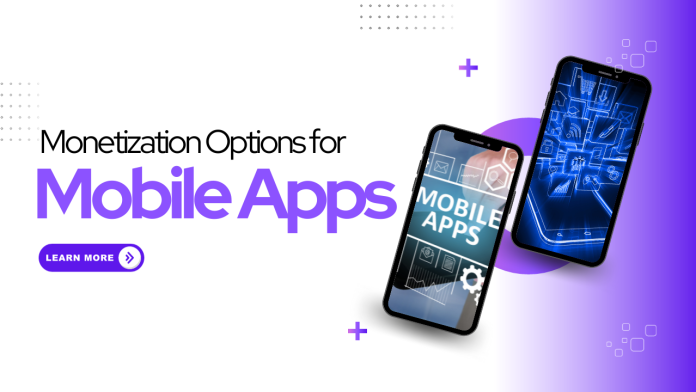You’ve just developed a brilliant mobile app that has users raving about its features and functionality.
Now, the big question looms – how do you turn those rave reviews into revenue?
That’s where the magic of app monetization comes in. It’s the art of transforming user engagement into tangible value, and it’s a journey worth embarking on.
In this guide, we’ll embark on a quirky exploration of various monetization options, helping you navigate the twists and turns of the app monetization rollercoaster. So, fasten your seatbelt, and let’s dive into the world of turning app brilliance into bankable success!
Types of Monetization Models
With millions of apps available across various platforms, developers are constantly seeking effective ways to generate revenue from their creations. This section delves into the various monetization models that app developers employ to sustain their endeavors and provide valuable services to users.
In-App Advertising
In-app advertising stands as one of the most prevalent monetization strategies, allowing developers to offer their applications for free while generating revenue through advertisements. There are several types of in-app ads that can be integrated seamlessly into the user experience:
Banner Ads:
Banner ads are perhaps the most recognizable form of in-app advertising. They typically appear at the top or bottom of the screen, displaying static or dynamic content. Banner ads are unobtrusive, allowing users to interact with the app while still being exposed to promotional content.
Interstitial Ads:
Interstitial ads are full-screen advertisements that appear at natural transition points within an app, such as between levels in a game or during a pause in a reading application. Their immersive nature captivates the user’s attention, making them an effective means of promoting products or services.
Native Ads:
Native ads are designed to blend seamlessly with the app’s existing content, ensuring a non-disruptive user experience. These ads mimic the look and feel of the app, appearing as organic elements within the interface. By providing value to users while subtly promoting products, native ads have proven to be a powerful monetization tool.
Freemium Model
The freemium model strikes a balance between offering a basic version of an app for free and providing premium features or content for a fee. This approach entices users to download and engage with the app, while offering enticing incentives to upgrade to the paid version. Freemium models often lead to a larger user base and increased exposure, which can translate to higher conversion rates for premium offerings.
In-App Purchases
In-app purchases involve the sale of digital goods or services within an application. This model is particularly popular in gaming apps, where players can buy virtual items, upgrades, or additional levels. By providing a seamless purchasing experience and valuable content, developers can create a steady stream of revenue from engaged users.
Subscription Model
The subscription model involves offering access to an app’s premium features or content on a recurring basis, typically monthly or annually. This approach provides a reliable source of revenue for developers and ensures ongoing value for subscribers. Subscription-based apps are prevalent in categories like streaming services, productivity tools, and content platforms.
Sponsorship and Partnerships
Sponsorship and partnerships present an alternative approach to monetization, where developers collaborate with brands or businesses to integrate their products or services within the app. This can take the form of sponsored content, branded experiences, or exclusive offers for users. By aligning with relevant partners, developers can diversify their revenue streams and enhance the overall user experience.
Choosing and Optimizing Your App’s Monetization Strategy
Monetizing a mobile application requires meticulous consideration of various factors. Here’s an expanded guide to assist you in selecting the right approach:
Understanding Your Audience
Gain valuable insights by analyzing demographics, preferences, and behaviors of your target audience. Utilize surveys, feedback, and comprehensive data analysis to inform your decision-making process. This information will be instrumental in selecting the most effective monetization model for your mobile application.
Aligning with App Content
Choose a monetization model that complements your app’s content and functionality, ensuring it seamlessly aligns with the app’s inherent value.
Competitor Analysis
Conduct a comprehensive analysis of revenue strategies employed by similar apps in your niche. Take note of their successes and areas where they may have faced challenges. Utilize these insights to fine-tune and optimize your own approach for monetization.
Prioritizing User Experience
Ensure that the selected monetization model enhances the user experience, avoiding any intrusive ads or pricing structures that could potentially disrupt it. Keep the focus on providing a seamless and enjoyable interaction for users.
Implementing In-App Advertising
Select ad networks and mediation platforms that cater to your app’s audience and content. Thoughtfully strategize the placement of ads to ensure they have a significant impact. Test out different ad formats to pinpoint the most effective ones for your app.
Maximizing Freemium Model
Clearly articulate the distinctions between the basic and premium versions of your app. Ensure that even the limited features of the basic version offer substantial value to users. Lastly, employ compelling calls-to-action (CTAs) and incentives to motivate users to upgrade to the premium version.
Optimizing In-App Purchases
Develop an intuitively designed in-app store that showcases available items or features effectively. Set prices based on user value perception, market research, and competitive analysis. Implement periodic promotions, limited-time discounts, or bundled offers to stimulate purchasing behavior.
Building a Successful Subscription Model
Provide exclusive content, features, or services that are not available in the free version of the app. Demonstrate a commitment to continuous improvement by providing regular updates, bug fixes, and new features to subscribers. Allow subscribers to customize their experience, such as personalized recommendations, themes, or settings.
Exploring Sponsorship and Partnerships
Identify sponsors whose products or services align with the interests and demographics of your app’s user base. Clearly define terms, deliverables, and expectations in the sponsorship agreement. Collaborate with sponsors on co-branded campaigns, promotions, or events within the app to generate revenue and provide added value to users.
Analyzing User Behavior
Monitor how often users engage with the app and how long they spend per session to gain insights into overall user interest and satisfaction. Examine the steps users take within the app, from initial interaction to conversion, to identify potential points of friction or drop-off. Incorporate user feedback into the optimization process to address concerns and make data-driven improvements.
Avoiding Monetization Pitfalls
Avoid overloading the app with ads, which can lead to user fatigue and frustration. Prioritize user experience by optimizing app performance, ensuring intuitive navigation, and maintaining a cohesive design. Actively use feedback and analytics to inform ongoing improvements in your monetization strategies.
Legal and Ethical Considerations
Ensure compliance with data protection laws and regulations, such as GDPR or CCPA, by clearly communicating how user data is collected, stored, and used. Familiarize yourself with the policies and guidelines of the app store platforms where your app is listed to avoid potential removal or penalties. Clearly communicate monetization methods to users, providing opt-out options for certain methods like personalized ads.
Measuring Monetization Success
Track revenue-related KPIs, including total revenue, average revenue per user (ARPU), and customer lifetime value (CLTV). Utilize analytics platforms to track and analyze user behavior, conversion funnels, and revenue-related metrics. Implement iterative improvements based on insights gained from data analysis, A/B testing, and user feedback.
Conclusion
In conclusion, the success of a mobile app hinges on a well-executed monetization strategy. By understanding the intricacies of each model and tailoring them to the app’s unique value proposition, developers can unlock the full potential of their creations. With thoughtful consideration and continuous optimization, app monetization can not only drive revenue but also enhance user experience, leading to long-term success in the competitive app market.
Get professional expertise in mobile app monetization with a leading mobile app development company in Kolkata.
Author Bio
 Sourav Dutta, a marketing maestro, boasts over a decade in the field. As a key figure at Excellis IT, a leading software development and digital marketing firm, he orchestrates impactful campaigns. Sourav’s forward-thinking strategies and tech-savvy approach have propelled Excellis IT to new heights. A prolific writer and speaker, his insights influence marketers at all levels.
Sourav Dutta, a marketing maestro, boasts over a decade in the field. As a key figure at Excellis IT, a leading software development and digital marketing firm, he orchestrates impactful campaigns. Sourav’s forward-thinking strategies and tech-savvy approach have propelled Excellis IT to new heights. A prolific writer and speaker, his insights influence marketers at all levels.






